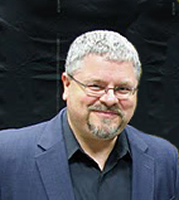Music director Tõnu Kalam fields the largest student orchestra of any university in the region. The members of the University of North Carolina Symphony Orchestra certainly filled the stage of Beasley-Curtis Auditorium, Memorial Hall. There were fourteen cellos, twelve violas, eight double basses, and some thirty-three violins. In addition to the standard woodwinds there were bastions of brass, five French horns, three trombones, three trumpets, and one tuba along with timpani too. The program was presented without intermission: two short transcriptions of a Bach chorale and an attributed Bach aria were followed by the challenging Fourth Symphony of Anton Bruckner (1824-96). Both composers were skilled organists and both were deeply religious – with Bach being a Protestant and Bruckner, a Catholic – all of which deeply influenced their compositional styles.
Kalam chose interesting transcriptions. Instead of ones by Leopold Stokowski, J. S. Bach’s “Wachet auf, ruft uns die Stimme,” S. 645 was heard as transcribed by Sir Granville Bantock. The aria, “Bist du bei mir,” S. 508 (formerly attributed to Bach) by Gottfried Heinrich Stölzel (1690-1749), was orchestrated by Thomas Frost, a longtime recording producer for Columbia Masterworks, CBS, and Sony Classical, who worked closely with Eugene Ormandy and the Philadelphia Orchestra. The high level of string playing was immediately obvious. Each section phrased as if by one player, with no laggards and with instant response to shifts in dynamics. Musical lines were clear if well upholstered.
Bruckner is not often programmed by our regional professional orchestras because of the expense of extra players and, perhaps, the box office. The Eastern Music Festival, with two large student orchestras and its faculty professional orchestra, and perhaps the UNC School of the Arts, have been the most consistent sources of performances of Bruckner’s works.
What an incredible pleasure it was to hear Kalam and his wonderfully well-prepared huge orchestra tear into Bruckner’s Symphony No. 4 in E-flat, “Romantic,” (1878/80) version! Bruckner scored the sections of the orchestra like an organ with huge blocks of sonorities planned upon a vast architecture in sound. These blocks came through like huge waves with delicate, chamber music-like troughs between them.
The strings played the pp tremolos beautifully, wonderfully hushed, and led to the perfect playing of the opening solo horn by Emily Farmer who sustained a high level of performance throughout the some 65 minutes of the work. The alterations and repetitions of the huge expanses of sonority came off superbly. What a thrill it was when the huge brass section unleashed a fff!
The second movement was ideally paced. The string pizzicatos were powerful while both the viola and cello sections produced such a plush, rich resonance. The woodwinds’ quality was excellent in the quieter episodes. The third movement, marked “Hunting Scherzo,” opened with all five horns soaring over hushed strings. Its surging and turbulent pace was a constant pleasure. Kalam built up the finale skillfully as each element was ratcheted to the soaring climax.











